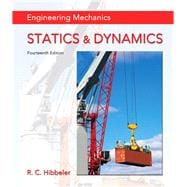NOTE: Before purchasing, check with your instructor to ensure you select the correct ISBN. Several versions of Pearson's MyLab & Mastering products exist for each title, and registrations are not transferable. To register for and use Pearson's MyLab & Mastering products, you may also need a Course ID, which your instructor will provide.
Used books, rentals, and purchases made outside of Pearson
If purchasing or renting from companies other than Pearson, the access codes for Pearson's MyLab & Mastering products may not be included, may be incorrect, or may be previously redeemed. Check with the seller before completing your purchase.
For Statics, Dynamics, and Combined Statics & Dynamics Courses.
A proven approach to conceptual understanding and problem-solving skills
Engineering Mechanics: Statics & Dynamics excels in providing a clear and thorough presentation of the theory and application of engineering mechanics. Engineering Mechanics empowers students to succeed by drawing upon Prof. Hibbeler’s everyday classroom experience and his knowledge of how students learn. The text is shaped by the comments and suggestions of hundreds of reviewers in the teaching profession, as well as many of the author’s students.
The 14th Edition features Preliminary Problems to help students develop conceptual understanding and build problem-solving skills. The text also provides a large variety of problems with varying levels of difficulty that cover a broad range of engineering disciplines and stress practical, realistic situations encountered in professional practice.
Mastering™ is the teaching and learning platform that empowers you to reach every student. By combining trusted author content with digital tools developed to engage students and emulate the office-hour experience, Mastering personalizes learning and often improves results for each student. Tutorial exercises and author-created tutorial videos walk students through how to solve a problem, consistent with the author’s voice and approach from the book.
0135881277/9780135881279 Engineering Mechanics: Statics & Dynamics, 14/e Plus Modified Mastering Engineering Revision with Pearson eText -- Access Card Package, 14/e
Package consists of:
- 0133915425/9780133915426 Engineering Mechanics: Statics & Dynamics, 14/e
- 0135699185/9780135699188 Modified Mastering Engineering Revision with Pearson eText -- Standalone Access Card -- for Engineering Mechanics: Statics & Dynamics, 14/e









